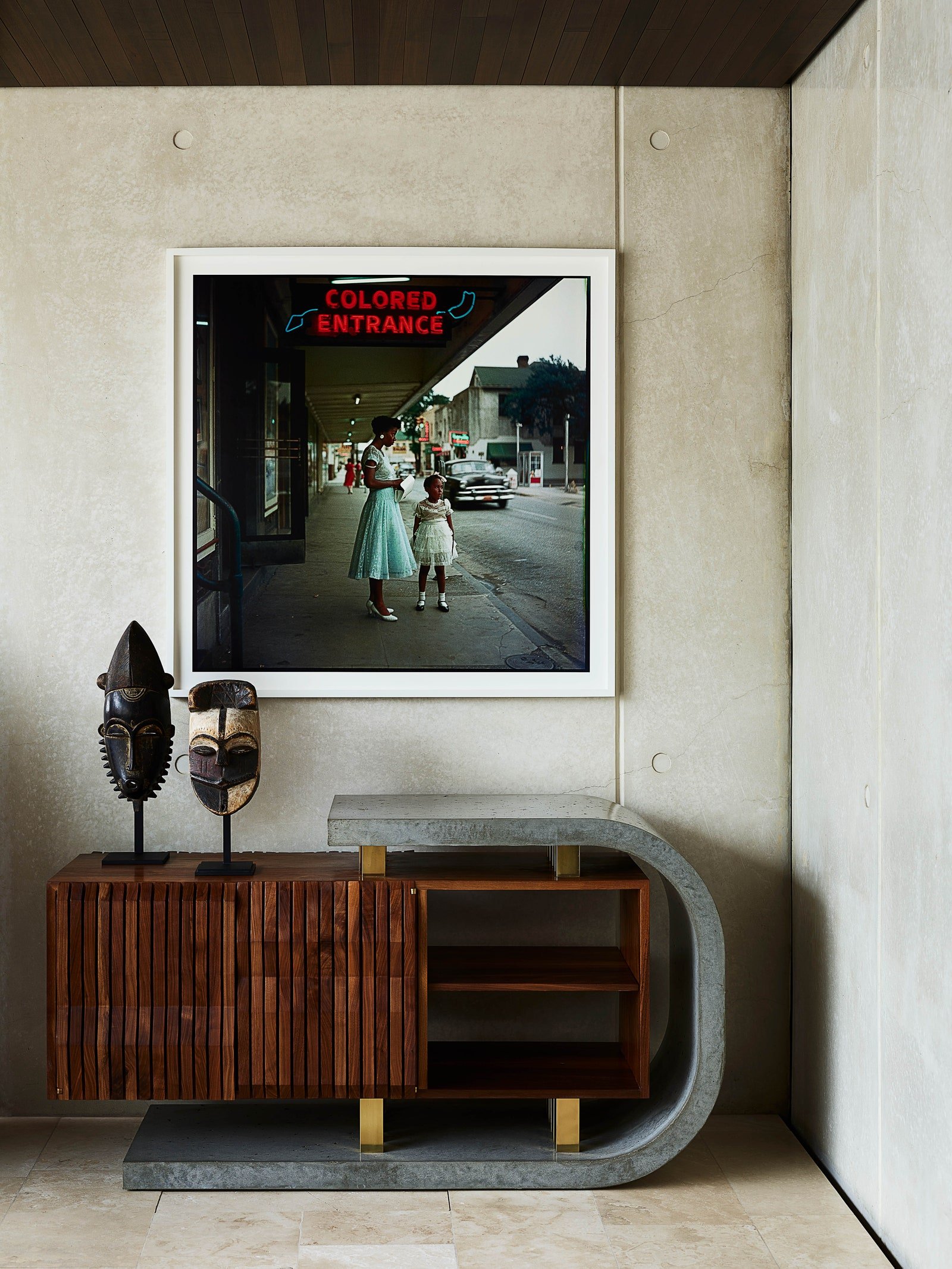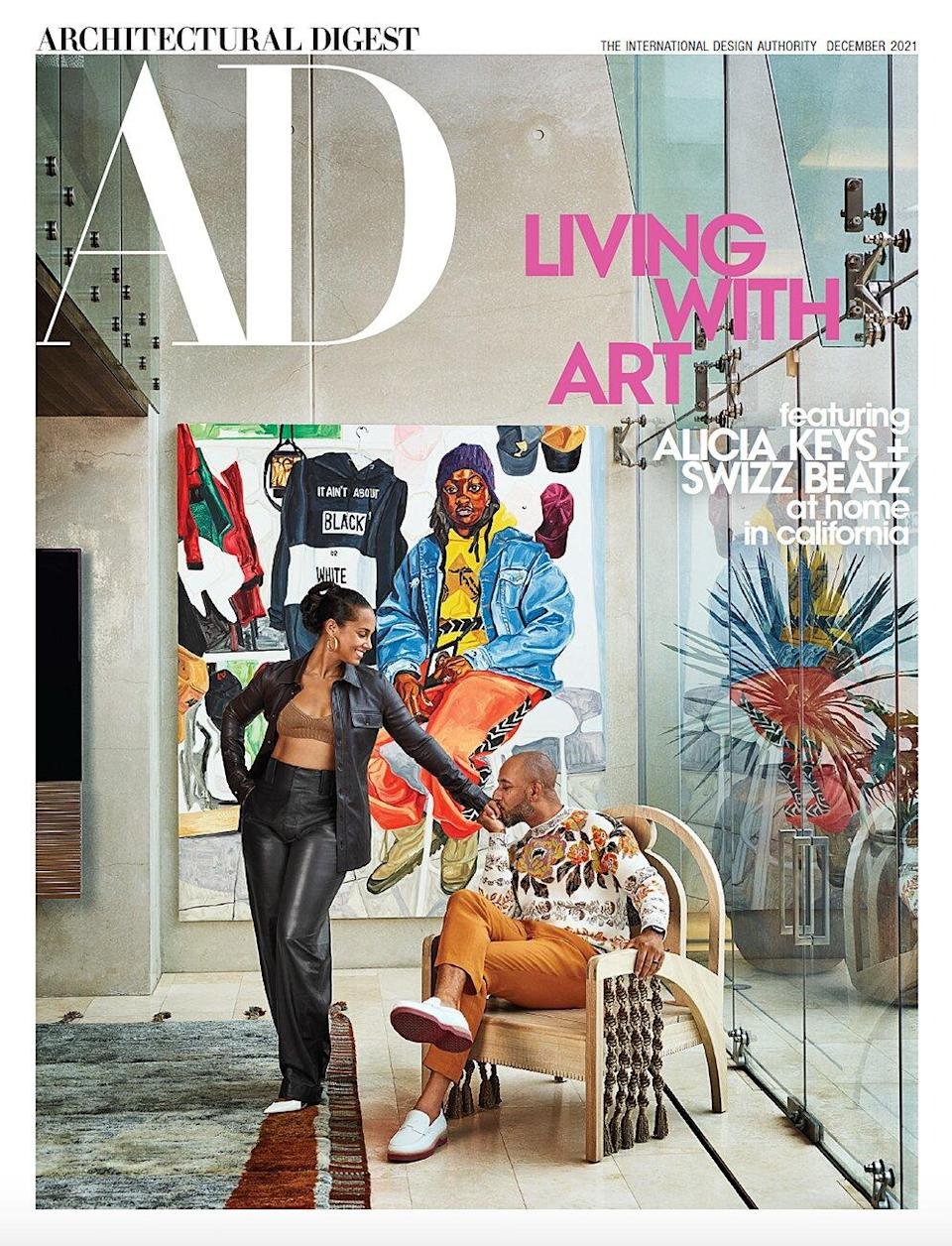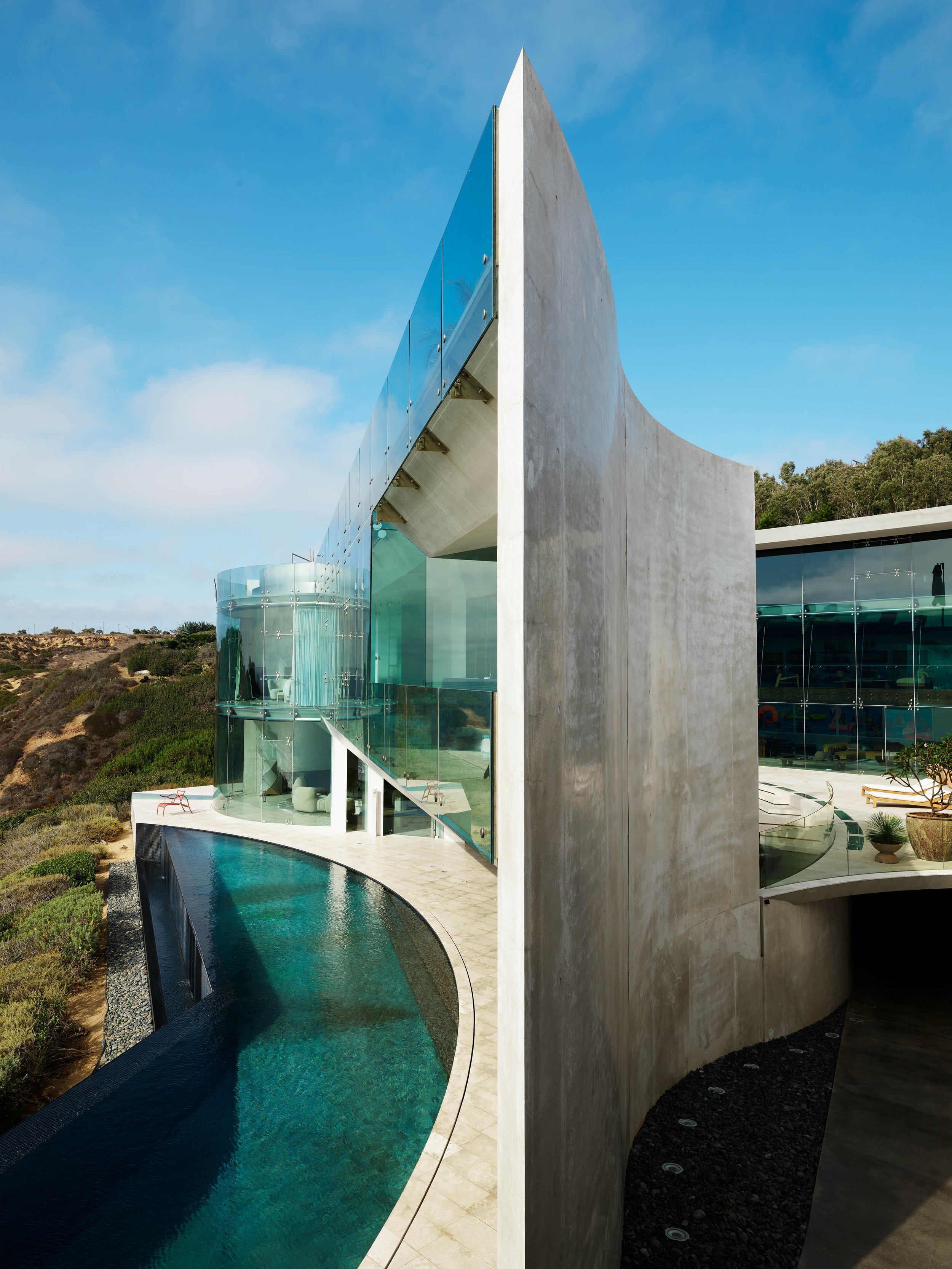Designer Jessie Nelson was studying post-war Eastern European architecture (noting its oppressive, yet fascinating sculptural perspective) when he began working in concrete—the primary material of his Side I table. In his Brooklyn studio, each pour of the industrial building material results in a unique finish with air pockets dotting the furniture’s surface. As functional as it is sculptural, with nods to Art Deco, Brutalism and Japanese wabi-sabi, the table’s walnut wood drawer is lined in a Fortuny fabric and features a secret compartment accessed by a hidden latch.
SURFACE MAGAZINE: Designer of the Day →
DESIGNER OF THE DAY
Designer of the Day: Jessie Nelson
Jessie Nelson thinks of craftsmanship in musical terms—no surprise considering he’s currently touring with a metal band. This approach allows the Brooklyn-based furniture designer and fabricator to respectfully nod to movements like Brutalism, Retrofuturism, and the Bauhaus in his work while ultimately freeing himself of aesthetic restraints that may box others in, yielding idiosyncratic pieces that don’t feel fussy or overwrought.
BY RYAN WADDOUPS
Here, we ask designers to take a selfie and give us an inside look at their life.
Age: 40
Occupation: Furniture designer/fabricator.
Instagram: @jessienelsonstudio
Hometown: Green River, WY.
Studio location: Gowanus, Brooklyn, and Lincoln Heights, Los Angeles.
Describe what you make: Collectibles. Unique pieces that challenge your perception of the limitations of materials.
CREEM MAGAZINE: How To Build A Record Shelf →
ARCHITECTURAL DIGEST: Inside Alicia Keys and Swizz Beatz’s Home
I’m proud to share that my Board 1 is prominently paired with a photo by the iconic Gordon Parks in the home of Alicia Keys and Swizz Beatz. The home is a breathtaking modern mansion designed by the great Wallace E. Cunningham. READ MORE
Photography by Frank Frances Studio



FORTUNY: A Conversation with Jessie Nelson
We sit down with Jessie Nelson, the New York based artist, audio engineer and furniture designer behind Knuckle On Bone, the latest addition to the bespoke furniture line represented in Fortuny’s New York showroom. The pursuit of creativity and artisanship through attention to details and open-mindedness towards various sources of inspiration, be it music, materials, people, cities, and the world at large – are what align Fortuny and Jessie Nelson Studio.
Q: You are a musician, audio engineer and furniture designer. We learned that your brother is a tattoo artist. Tell us a little bit about your upbringing and how that may have influenced your creative endeavors.
We’re first generation born in the Rocky Mountains. Our mother is from the Philippines and of the few things she brought with her was a relentless work ethic and positive demeanor which we witnessed and in hind sight, inherited. She imposed piano lessons upon us at an early age. As much as this may have pained boys who wanted to be outside, it’s introduced me to the relationship with my hands and the benefits of discipline. There were times when learning to play was painful, a song or rhythm seemed too hard to coordinate between both hands, or a lesson was too redundant to hold my attention, but lessons taught me early on that progress is only gained through focus and persistence. When you can stand on the winning side of a technical task, you know there was no short-cut to get there. No one can get you there but yourself and now your skill set is greater. Furthermore, it can’t be taken from you. Nothing looks or sounds good the first time you take a stab at it, but with discipline and intent, it gets better, opens up new abilities and ideas that were once out of reach are now at your mercy. This progress became an early addiction and the creativity and freedom began to flow from there. Oh, and chores. Lots of after school chores…that’s where good work ethic comes from. Thanks mom!
The outlook from our small town was rather bleak, and we knew early on we had outgrown it. A lot of our childhood was spent studying cultures. Skipping church to read magazines at the grocery store took us to other worlds that co-existed beyond our reach. Music was the guiding light and escape vessel. There was freedom knowing the stifling feeling of a small town was temporary and we could create our own existence once we were out on our own.
“[piano] lessons taught me early on that progress is only gained through focus and persistence. When you can stand on the winning side of a technical task, you know there was no short-cut to get there.”
Q: At Fortuny, we value both the technical savoir-faire and the creative rebellion that brings an object into the realm of art. Our fabrics are artisanally made in Venice. Your furniture is hand-made in New York. Tell us about your process of creating and how important it is to be in control of the fabrication process?
Being the designer and fabricator takes me on all kinds of adventures while sourcing materials. I enjoy the process of establishing relationships with my vendors. They know me by name and a few of them have become friends outside of the work realm. I feel like there’s much more to be gained by meeting people who are closely tied to their products, than there is from just placing orders. They become invested in my process and an integral part of the production.
I shamelessly go through entire stacks of walnut looking for the grain that’ll be the faces of my pieces. My work is intentionally made to order. I fabricate each piece to ensure that it’s up to my standards. One day I may have to hire others to help with production, but as of now, I really enjoy the work. It’s meditative and rewarding.
Q: For Knuckle On Bone, you struck a balance between radical brutalism and organic, natural elements. Tell us about how you came up with this collection.
I gave myself a limited palette of wood, concrete, brass and leather, and let the materials dictate the design. I had ideas that required certain parameters to operate within but as the process took shape, I let go of what I had envisioned and trusted my gut. Each material carries a weight, an energy, a preconceived familiarity. I wanted to challenge these. I wanted to make concrete feel soft. I wanted to tone down the gaudiness of brass. And I wanted to let the wood grain tell its story. These materials on their own speak to different associations, but when married together, they create a new conversation. I have a hard time relating to furniture that is fabricated so perfectly that it loses its human connection. This is why I enjoy working with concrete. It fascinates me as a wood worker, because I’m allowed to make arcs and curves. Once it’s poured in the mold, it’s no longer in my control. The air pockets are completely random which introduces a bit of the wabi-sabi aesthetic. I love imperfections, flaws; it’s woven into the fabric of who we are. To deny that feels like a bit of betrayal.
Q: Knuckle On Bone is a very beautiful collection and we are very proud to have some pieces here in our showroom. What was the catalyst behind this collection? Do you see this as a collection that will grow with new designs or pieces under the KOB moniker or are you considering it a capsule collection? Anything you can share on what new designs or pieces will be coming up?
I’m intrigued by the design of architecture that came from post-war Yugoslavia. The cultural climate was so rebellious and free. The area was torn apart by World War II and they created a new identity separate from the capitalist West and Communist East. It’s reflected in the architecture as they forged a new way of life, pushing boundaries as they went along.
Everything was intentional and unconventional, designing buildings to allow direct sunlight into each room, elevating structures to integrate the landscape surrounding it. The use of concrete allowed them so much freedom in form. Design was functional and sculptural. This attitude was incorporated into Knuckle on Bone. The BOARD: 01 was designed with the audiophile in mind. Concrete coincidentally is an ideal surface for a turntable. The shelf space is made to fit hi-end components. The cabinet holds a vinyl collection, with space for brushes and cleaners etc. It can be used for anything really, but the real audiophile would be thrilled with the functionality of it. The fluidity of that modern movement freed me from the square nature of traditional wood working. KOB is a limited edition capsule collection. I continue to work with this palette, but there will be a new theme, and purpose.
“I have a hard time relating to furniture that is fabricated so perfectly that it loses its human connection. I love imperfections, flaws; it’s woven into the fabric of who we are. To deny that feels like a bit of betrayal.
Q: Talk about your process. How do your designs begin? Is it a sketch, a thought, a model? What do you do to get your inspiration and creative juices flowing?
I see something that catches my eye, a shape, the pattern on a air vent, or a water fountain in a public park. I can imagine it spun upside down or hollowed out, potentially used in a different application. Other times it’s finding a scratch that hasn’t been itched yet, I see an overlooked area that could be investigated further. Moments of “well this would be better if….” And of course the natural world. I recently thumbed through Mark Laita’s book Serpentine. The colors, patterns and shapes that naturally occur in these snakes are hypnotizing. If ever you need a color palette, just get out of the city and look around you. It’s everywhere.
Pop Quiz
Q: What designer, dead or alive, would you most like to meet?
I’m a fan of Dieter Rams aesthetic and philosophy of design. He made things functional without being fussy. So futuristic for the time and is still very relevant. You don’t have to look further than the calculator on your iPhone to see his influence. Clean lines, simple color palette, honest materials, simple solutions for complex problems, yet comprehendible and playful. He’d be a great person to sit across from with a cup of coffee and a sketch pad.
Q: Do you have a favorite furniture designer? Is there a particular piece of theirs that you wish you had designed?
I made the pilgrimage to George Nakashima’s studio a year back. Seeing his work, the house, tools, slab closet is breathtaking. It’ll take a lifetime to understand material like he did, he listened to the material more than forcing it, giving it a “second life” as he said. I visited the Wright Gallery here in the city and found myself crawling underneath one of his credenzas examining the craftsmanship of his joinery. One day, I’ll get there.
Q: Name your favorite musician
Hard to say favorite, but Nick Cave is in the top 5. He’s always working, always pushing himself. Always had swagger, never lost the plot or held onto an era that had passed. He’s endured so much over his lifetime, love, loss, death, addiction, you name it, yet spins it into a beautiful body of work that isn’t just in music, but film, and writing, acting. It’s honest, gripping, and incredible.
Q: Put together your fantasy dream band.
Drums: Robert Nelson (brother, his band is Skullshitter)
Guitar: Martin Gore (Depeche Mode)
Keys: Nils Frahm
Bass: Paul Simonon (The Clash)
Vocals: Nick Cave
Q: What instruments do you play?
Keys and guitar.
Q: If you had to pick one musical instrument to represent you, what would it be and why?
Living in NYC, the closest I get to having a piano at home is my fender Rhodes. It’s therapeutic to come home and play keys that doesn’t require headphones. Some of the keys are chipped, and has some other characteristics that make it not so precious. I relate to things that have dings and dents I suppose.
Q: Your biggest crush is coming to NY for the first time for only one day. What will you take them to see and where will you eat?
Well, first, she’ll be able to ride a bike since it’s the best way to get around the city. Since I am in control of this ideal scenario it’s spring, New Yorkers are feeling alive for the first time in 6 months, and the city’s coming alive, a stroll along the highline has it all converging at once. The battle between man and nature is on full display . The urban decay of life persevering through the cracks and abandoned tracks is ongoing and beautiful. I’m a downtown resident but recently stumbled into Shalel Lounge on the UWS and it was fantastic. Moroccan fare in a discreet, dimly lit basement with little nooks and cozy corners that make you forget you’re in a dimly lit basement. Followed by post-dinner riff raff at Satsko’s Sake Bar in the East Village. Very important place where much was learned over the last decade.
Q: What city would you most want to live in if you had to move from New York?
Hard to imagine another urban dwelling after New York. I’d opt for some space. I hear Portugal is nice.
Q: What item have you recently brought back from a trip that makes you happy?
I went on a camping trip the last weekend on summer and was gifted the fireside acoustic guitar at the end of it.
Q: What is the last book you read that you really connected with?
Bogdanovic by Bogdanovic. Picked it up at the MoMA recently. He designed monuments, mausoleums, cenotaphs. We see these beautiful sculptures all over social media but have little understanding the thoughts behind them. He went back to his work to photograph it years later. It’s a testament to his work through his own eyes.




